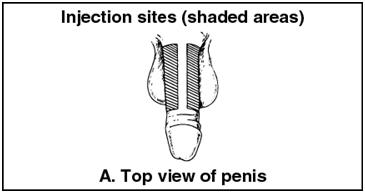CAVERJECT- alprostadil injection, powder, lyophilized, for solution
Caverject by
Drug Labeling and Warnings
Caverject by is a Prescription medication manufactured, distributed, or labeled by Pharmacia & Upjohn Company LLC, Pfizer Inc. Drug facts, warnings, and ingredients follow.
Drug Details [pdf]
-
HIGHLIGHTS OF PRESCRIBING INFORMATION
These highlights do not include all the information needed to use CAVERJECT safely and effectively. See full prescribing information for CAVERJECT.
CAVERJECT ® (alprostadil) for injection, for intracavernosal use
Initial U.S. Approval: 1981INDICATIONS AND USAGE
DOSAGE AND ADMINISTRATION
- Determine the most suitable dose and formulation of CAVERJECT to use. Use a new vial for each dose of CAVERJECT (2.1).
- Administer first intracavernosal injections in the physician's office and titrate the dose for each patient to the lowest effective dose (2.1).
- Instruct the patient on proper use and assess that they are well trained in the self-injection technique prior to initiation of at-home use (2.1).
- Recommended dosage for erectile dysfunction (2.2):
- Erectile dysfunction of vasculogenic, psychogenic, or mixed etiology: Initiate dosing with 2.5 mcg
- Erectile dysfunction of pure neurogenic etiology (spinal cord injury): Initiate dosing with 1.25 mcg
- Follow dose titration procedures for each type of erectile dysfunction and determine the maintenance dosage for erectile dysfunction for patient home use in the physician's office (2.2).
- The recommended frequency of injection is no more than 3 times weekly, with at least 24 hours between each dose (2.2).
- While on self-injection treatment, the patient should visit the prescribing physician's office every 3 months to assess the efficacy and safety of the therapy (2.2).
- Follow the procedure for CAVERJECT syringe preparation (2.3).
- Follow procedure for CAVERJECT intracavernosal injection administration (2.4).
- To diagnose erectile dysfunction (pharmacologic testing), inject CAVERJECT intracavernosally and monitor patients for the occurrence of an erection (2.5).
DOSAGE FORMS AND STRENGTHS
For injection: 20mcg and 40mcg lyophilized powder in single-dose vials for reconstitution (3).
CONTRAINDICATIONS
- Men who have known hypersensitivity to the drug (4).
- Men who have conditions that predispose them to priapism, such as sickle cell anemia or sickle cell trait, multiple myeloma, or leukemia (4).
- Treatment of erectile dysfunction in men with fibrotic conditions of the penis, such as anatomical deformation, angulation, cavernosal fibrosis, or Peyronie's disease (4).
- Men with penile implants (4).
WARNINGS AND PRECAUTIONS
- Prolonged erection and priapism have occurred in patients receiving CAVERJECT. To minimize the chances of this occurring, titrate CAVERJECT slowly to the lowest effective dose (2.1). Advise patients to seek immediate medical assistance for an erection that persists longer than 4 hours (5.1).
- Penile fibrosis has occurred in patients receiving CAVERJECT. Follow patients regularly to detect signs of penile fibrosis. Discontinue in patients who develop penile angulation or cavernosal fibrosis (5.2).
- Hypotension: Injections of CAVERJECT can lead to increased peripheral blood levels of alprostadil, especially in patients with significant corpora cavernosa venous leakage. Avoid use in patients with known cavernosal venous leakage (5.3).
- Injection site bleeding may occur in patients taking anticoagulants, such as warfarin or heparin. Compress the site of injection with an alcohol swab or sterile gauze for 5 minutes (5.4).
- Cardiovascular risk related to underlying medical conditions: Underlying treatable medical causes of erectile dysfunction should be diagnosed and treated prior to initiation of therapy (5.5).
- Risks of use in combination with other vasoactive medications injected intracavernosally: Safety and efficacy of combinations of CAVERJECT and other vasoactive agents have not been systematically studied. Use of such combinations is not recommended (5.6).
- Needle breakage: CAVERJECT uses a superfine needle and cases of needle breakage have been reported. Careful instruction in proper patient handling and injection techniques may minimize this risk (5.7).
- Benzyl alcohol: Serious and fatal adverse reactions can occur in neonates and low birth weight infants treated with benzyl alcohol-preserved formulations in infusion solutions, including CAVERJECT. CAVERJECT is not indicated in neonates and infants (5.8).
- Counseling patients about sexually transmitted diseases: Counsel patients about the protective measures necessary to guard against sexually transmitted disease including the Human Immunodeficiency Virus (HIV) (5.9).
ADVERSE REACTIONS
The most common (≥10%) adverse reaction is penile pain (6.1).
To report SUSPECTED ADVERSE REACTIONS, contact Pfizer at (1-800-438-1985 and www.pfizer.com) or FDA at 1-800-FDA-1088 or www.fda.gov/medwatch.
See 17 for PATIENT COUNSELING INFORMATION and FDA-approved patient labeling.
Revised: 12/2017
-
Table of Contents
FULL PRESCRIBING INFORMATION: CONTENTS*
1 INDICATIONS AND USAGE
1.1 Erectile Dysfunction
1.2 Diagnostic Testing for Erectile Dysfunction
2 DOSAGE AND ADMINISTRATION
2.1 Important Dosage and Administration Instructions
2.2 Recommended Dosage for Erectile Dysfunction
2.3 Preparation Instructions
2.4 Administration Instructions
2.5 Adjunct to the Diagnosis of Erectile Dysfunction
3 DOSAGE FORMS AND STRENGTHS
4 CONTRAINDICATIONS
5 WARNINGS AND PRECAUTIONS
5.1 Prolonged Erection and Priapism
5.2 Penile Fibrosis
5.3 Hypotension
5.4 Injection Site Bleeding When Used With Anticoagulants
5.5 Cardiovascular Risk Related to Underlying Medical Conditions
5.6 Risks of Use in Combination with Other Vasoactive Medications Injected Intracavernosally
5.7 Needle Breakage
5.8 Risk of Serious Adverse Reactions in Infants due to Benzyl Alcohol Preservative
5.9 Counseling Patients about Sexually Transmitted Diseases
6 ADVERSE REACTIONS
6.1 Clinical Trials Experience
6.2 Postmarketing Experience
7 DRUG INTERACTIONS
8 USE IN SPECIFIC POPULATIONS
8.1 Pregnancy
8.2 Lactation
8.4 Pediatric Use
8.5 Geriatric Use
10 OVERDOSAGE
11 DESCRIPTION
12 CLINICAL PHARMACOLOGY
12.1 Mechanism of Action
12.3 Pharmacokinetics
13 NONCLINICAL TOXICOLOGY
13.1 Carcinogenesis, Mutagenesis, Impairment of Fertility
14 CLINICAL STUDIES
16 HOW SUPPLIED/STORAGE AND HANDLING
17 PATIENT COUNSELING INFORMATION
- * Sections or subsections omitted from the full prescribing information are not listed.
- 1 INDICATIONS AND USAGE
-
2 DOSAGE AND ADMINISTRATION
2.1 Important Dosage and Administration Instructions
- CAVERJECT is available in single-dose vials containing 20 mcg or 40 mcg of alprostadil. Make sure a new, correct strength vial of CAVERJECT is used for each patient dosage preparation.
- Administration of the first injections of CAVERJECT should be done in the physician's office by medically trained personnel.
- Carefully titrate the dose of CAVERJECT for each patient to the lowest effective dose.
- Instruct the patient on proper use and assess that they are well trained in the self-injection technique prior to initiation of home use. Advise the patient to read and carefully follow the Patient Information and Instructions for Use.
2.2 Recommended Dosage for Erectile Dysfunction
Erectile Dysfunction of Vasculogenic, Psychogenic, or Mixed Etiology
- Initiate dosing with 2.5 mcg of alprostadil.
- If there is a partial response at 2.5 mcg, the dose may be increased to 5 mcg within 1 hour. Use a new vial for each dose of CAVERJECT.
- During titration, no more than 2 doses should be given within a 24-hour period.
- The optimal dose should produce an erection suitable for intercourse that does not exceed a duration of 1 hour.
- The patient must stay in the physician's office until complete detumescence occurs.
If additional titration is required, doses in increments of 5 to 10 mcg may be given at least 24 hours apart. Repeat the titration as necessary until the optimal dose is achieved. Doses greater than 60 mcg are not recommended.
Erectile Dysfunction of Pure Neurogenic Etiology (e.g., Spinal Cord Injury).
- Initiate dosing with 1.25 mcg of alprostadil.
- If there is a partial response, the dose may be increased to 2.5 mcg within 1 hour. Use a new vial for each dose of CAVERJECT.
- During titration, no more than 2 doses should be given within a 24-hour period.
- The optimal dose should produce an erection suitable for intercourse that does not exceed a duration of 1 hour.
- The patient must stay in the physician's office until complete detumescence occurs.
If additional titration is required, a dose of 5 mcg may be given during the next 24 hours. Thereafter, doses in increments of 5 mcg may be given at least 24 hours apart until the optimal dose is reached. Doses greater than 60 mcg are not recommended.
Maintenance Dosage for Patient Home Use
- Once the dose of CAVERJECT has been determined in the physician's office, additional dose adjustment may be required after consultation with the physician. Adjust the dose in accordance with the titration guidelines described above.
- The recommended frequency of injection is no more than 3 times weekly, with at least 24 hours between each dose.
- Re-evaluate patients regularly (every 3 months or as clinically appropriate) and determine if dosage adjustments are needed.
2.3 Preparation Instructions
Supplies Needed and Not Supplied With CAVERJECT
- 1 mL of the diluent (bacteriostatic water for injection preserved with benzyl alcohol 0.945% w/v)
- 1 mL to 3 mL syringe, dependent on the titrated dose
- 21 to 27 gauge needle for reconstitution
- 29 or 30 gauge one-half inch needle for injection
- alcohol swabs
Reconstitution Instructions
- CAVERJECT vial(s): Using the correct strength vial containing 20 mcg or 40 mcg of CAVERJECT, use a 1 mL to 3 mL syringe, a 21 to 27 gauge needle and 1 mL of the diluent (bacteriostatic water for injection preserved with benzyl alcohol 0.945% w/v) for reconstitution. Reconstitution results in CAVERJECT 20 mcg/mL or 40 mcg/mL.
- Visually inspect the solution in the vial for particulate matter and discoloration. Do not use the solution if it is cloudy, colored or contains particles.
Table 1: Volume of CAVERJECT Solution to Inject using 1 mL syringe 20 mcg Vial 40 mcg Vial Dose Volume to Inject Dose Volume to Inject 1.25 mcg 0.06 mL 1.25 mcg --- 2.5 mcg 0.125 mL 2.5 mcg --- 5 mcg 0.25 mL 5 mcg 0.125 mL 10 mcg 0.5 mL 10 mcg 0.25 mL 15 mcg 0.75 mL 15 mcg 0.375 mL 20 mcg 1 mL 20 mcg 0.5 mL 25 mcg --- 25 mcg 0.625 mL 30 mcg --- 30 mcg 0.75 mL 40 mcg --- 40 mcg 1 mL - Draw the dose of CAVERJECT into the syringe.
- Replace the needle used for reconstitution with a 29 or 30 gauge one-half inch needle prior to injection.
- The reconstituted solution should be used within 24 hours when stored at or below 25°C (77°F).
Refer to the Patient Information and Instructions for Use in the FDA-approved patient labeling for the complete detailed instructions on reconstitution and needle preparation steps.
2.4 Administration Instructions
- Use a 29 or 30 gauge one-half inch needle for injecting each dose.
- The patient should be in a sitting or slightly reclined position when injecting a dose.
- Retract the foreskin in uncircumcised patients.
- Grasp the head of the penis with the thumb and forefinger and stretch it length-wise along the thigh.
- The site of injection is either the right or left lateral penis. See Figures A and B below.
- Wipe the intended injection site with an alcohol swab prior to injection.
- Insert needle perpendicular to the long dorsolateral penile axis in the proximal third of penis. Avoid angulation of the syringe and do not bend the needle.
- Avoid visible veins during injection.
- With each use of CAVERJECT, alternate the side of the penis that is injected.
- Compress the site of injection with an alcohol swab or sterile gauze for 5 minutes.
- CAVERJECT is intended for single patient use only and should be discarded after use.
2.5 Adjunct to the Diagnosis of Erectile Dysfunction
As an adjunct to the diagnosis of erectile dysfunction, inject CAVERJECT intracavernosally and monitor patients for the occurrence of an erection. Extensions of this testing are the use of CAVERJECT as an adjunct to laboratory investigations, such as duplex or Doppler ultrasound imaging. For any of these tests, use a single dose of CAVERJECT that induces a rigid erection.
- 3 DOSAGE FORMS AND STRENGTHS
-
4 CONTRAINDICATIONS
CAVERJECT is contraindicated:
- in men who have a known hypersensitivity to the drug [see Adverse Reactions (6.1)]
- in men who have conditions that predispose them to priapism, such as sickle cell anemia or sickle cell trait, multiple myeloma, or leukemia [see Warnings and Precautions (5.1)]
- for the treatment of erectile dysfunction in men with fibrotic conditions of the penis, such as anatomical deformation, angulation, cavernosal fibrosis, or Peyronie's disease [see Warnings and Precautions (5.2)]
- in men with penile implants.
-
5 WARNINGS AND PRECAUTIONS
5.1 Prolonged Erection and Priapism
Prolonged erection defined as erection lasting between 4 to 6 hours in duration occurred in 4% of 1,861 patients treated up to 18 months in studies of CAVERJECT. The incidence of priapism (erections lasting more than 6 hours in duration) was 0.4%. In the event of an erection that persists longer than 4 hours, the patient should seek immediate medical assistance. If priapism is not treated immediately, penile tissue damage and permanent loss of potency may result.
To minimize the chances of prolonged erection or priapism, CAVERJECT should be titrated slowly to the lowest effective dose [see Dosage and Administration (2.1)]. In addition, do not use CAVERJECT in patients who have conditions that predispose them to priapism, such as sickle cell anemia or sickle cell trait, multiple myeloma, or leukemia [see Contraindications (4)].
5.2 Penile Fibrosis
The overall incidence of penile fibrosis, reported in clinical studies with CAVERJECT was 3%. In one self-injection clinical study where duration of use was up to 18 months, the incidence of penile fibrosis was 7.8%.
Physical examination of the penis should be performed periodically, to detect signs of penile fibrosis. Treatment with CAVERJECT should be discontinued in patients who develop penile angulation or cavernosal fibrosis.
5.3 Hypotension
Intracavernous injections of CAVERJECT can increase peripheral blood levels of alprostadil which can result in hypotension. Avoid use of CAVERJECT in patients with known cavernosal venous leakage.
5.4 Injection Site Bleeding When Used With Anticoagulants
Patients on anticoagulants, such as warfarin or heparin, may have increased propensity for injection site bleeding after intracavernosal injection with CAVERJECT. Compress the site of injection with an alcohol swab or sterile gauze for 5 minutes.
5.5 Cardiovascular Risk Related to Underlying Medical Conditions
There is a potential for cardiac risk of sexual activity in patients with preexisting cardiovascular disease. Therefore, treatments for erectile dysfunction, including CAVERJECT, generally should not be used in men for whom sexual activity is inadvisable because of their underlying cardiovascular status. In addition, the evaluation of erectile dysfunction should include a determination of potential underlying causes and the identification of appropriate treatment following a complete medical assessment.
5.6 Risks of Use in Combination with Other Vasoactive Medications Injected Intracavernosally
The safety and efficacy of combinations of CAVERJECT and other vasoactive agents injected intracavernosally have not been established in clinical studies. The risks of prolonged erection, priapism, and hypotension may be increased.
5.7 Needle Breakage
Separate needles should be used for reconstitution and administration. CAVERJECT uses a superfine needle for administration. As with all superfine needles, the possibility of needle breakage exists. Needle breakage, with a portion of the needle remaining in the penis, has been reported and, in some cases, required hospitalization and surgical removal. Careful instruction in proper patient handling and injection techniques may minimize the potential for needle breakage [see Dosage and Administration (2.3) and Adverse Reactions (6.2)].
5.8 Risk of Serious Adverse Reactions in Infants due to Benzyl Alcohol Preservative
When reconstituted using the recommended diluent, the solution contains benzyl alcohol. Serious and fatal adverse reactions including "gasping syndrome" can occur in neonates and low birth weight infants treated with benzyl alcohol-preserved formulations in infusion solutions, including CAVERJECT. The "gasping syndrome" is characterized by central nervous system depression, metabolic acidosis, and gasping respirations. CAVERJECT is not indicated for use in neonates or infants.
5.9 Counseling Patients about Sexually Transmitted Diseases
The use of CAVERJECT offers no protection against sexually transmitted diseases. Counseling of patients about the protective measures necessary to guard against sexually transmitted diseases, including the Human Immunodeficiency Virus (HIV) is advised.
-
6 ADVERSE REACTIONS
The following are described elsewhere in the labeling:
- Prolonged Erection and Priapism [see Warnings and Precautions (5.1)]
- Penile Fibrosis [see Warnings and Precautions (5.2)]
6.1 Clinical Trials Experience
Because clinical trials are conducted under widely varying conditions, adverse reaction rates observed in the clinical trials of a drug cannot be directly compared to rates in the clinical trials of another drug and may not reflect the rates observed in clinical practice.
Local Adverse Reactions: Local adverse reactions derived from 1861 patients in clinical studies of CAVERJECT, including an 18-month, open-label study, are shown in Table 2.
Table 2. Local Adverse Reactions Reported by ≥ 1% of Patients Treated with CAVERJECT for up to 18 Months - * Penis disorder includes: numbness, irritation, sensitivity, pruritus, erythema, skin tear, discoloration, itching.
Penile pain 37% Prolonged erection 4% Penile fibrosis 3% Injection site hematoma 3% Penis disorder* 3% Injection site ecchymosis 2% Penile rash 1% Penile edema 1% The following local adverse reactions were reported in < 1% of patients: injection site hemorrhage, injection site inflammation, injection site itching, injection site swelling, injection site edema, urethral bleeding, penile warmth, numbness, irritation, sensitivity, pruritus, erythema, painful erection, and abnormal ejaculation.
In these studies, no local adverse reactions were reported in the 294 patients who received placebo, except for penile pain (2%).
Penile Pain: In the majority of the cases, penile pain was rated mild or moderate in intensity. Three percent of patients discontinued treatment because of penile pain
Prolonged Erection/Priapism: Prolonged erection was defined as an erection that lasted for 4 to 6 hours; priapism was defined as an erection that lasted 6 hours or longer. In clinical studies the frequency of prolonged erection after intracavernosal administration of CAVERJECT was 4%, while the frequency of priapism was 0.4% [see Warnings and Precautions (5.1)].
Penile Hematoma/Ecchymosis: In clinical studies the frequency of penile hematoma and ecchymosis was 3% and 2%, respectively.
Systemic Adverse Reactions: Systemic adverse reactions reported by ≥ 1% of subjects in clinical studies of CAVERJECT included: dizziness (1%).
The following systemic adverse reactions were reported in < 1% of patients: testicular pain, scrotal edema, hematuria, pelvic pain, hypotension, vasodilation, vasovagal reaction, diaphoresis, rash, and non-application site pruritus. Three patients (0.2%) discontinued due to symptomatic hypotension.
No systemic adverse reactions were reported in the 294 patients who received placebo.
In addition to the adverse reactions observed for CAVERJECT, the following adverse reactions have been reported in clinical studies of CAVERJECT IMPULSE:
CAVERJECT IMPULSE was evaluated in 87 patients in an open-label crossover study of 6 weeks treatment duration that compared the formulation of alprostadil for injection contained in CAVERJECT IMPULSE with the formulation contained in CAVERJECT. Doses used in this study ranged from 2.5 mcg to 20 mcg. Adverse reactions reported for the CAVERJECT IMPULSE formulation included: penis disorder (4.6%), prolonged erection (1.1%), injection site erythema (1.1%), rash (1.1%), dizziness (1.1%), and hematospermia (1.1%). Penis disorder included penile pain, post-injection pain, and pain with erection.
CAVERJECT IMPULSE was also evaluated in 63 patients in a single-dose, double-blind, crossover study that compared CAVERJECT IMPULSE with CAVERJECT. Doses used in this study ranged from 2.5 mcg to 20 mcg. Adverse reactions reported for the CAVERJECT IMPULSE formulation included: penile pain (1.6%) and pruritis (1.6%).
-
7 DRUG INTERACTIONS
The potential for pharmacokinetic drug-drug interactions between alprostadil and other agents administered orally or intracavernosally has not been formally studied [see Warnings and Precautions (5.6)].
-
8 USE IN SPECIFIC POPULATIONS
8.4 Pediatric Use
Safety and effectiveness have not been established in pediatric patients [see Warnings and Precautions (5.8)].
8.5 Geriatric Use
A total of 341 subjects included in clinical studies were 65 and older. No overall differences in safety and effectiveness were observed between these subjects and younger subjects, and the other reported clinical experience has not identified differences in responses between elderly and younger patients.
-
10 OVERDOSAGE
Overdosage was not observed in clinical trials with CAVERJECT. If intracavernous overdose of CAVERJECT occurs, the patient should be under medical supervision until any systemic effects have resolved and/or until penile detumescence has occurred. Treatment of any systemic symptoms (e.g., hypotension) would be appropriate.
-
11 DESCRIPTION
CAVERJECT contains alprostadil a synthetic form of prostaglandin E1 (PGE1) and is designated chemically as (11α,13E,15S)-11,15-dihydroxy-9-oxoprost-13-en-1-oic acid. The molecular weight is 354.49.
Alprostadil is a white to off-white crystalline powder with a melting point between 115°C and 116° C. CAVERJECT is available as a sterile freeze-dried powder for intracavernosal use in sizes: 20 mcg and 40 mcg per vial. When reconstituted as directed with 1 mL of bacteriostatic water for injection preserved with benzyl alcohol 0.945% w/v, gives 1.13 mL of reconstituted solution. Each mL of CAVERJECT contains 20.5 mcg or 41.1 mcg of alprostadil depending on vial strength, 172 mg of lactose, 47 mcg of sodium citrate and 8.4 mg of benzyl alcohol. The deliverable amount of alprostadil is 20 mcg or 40 mcg per mL because approximately 0.5 mcg for the 20 mcg strength and 1.1 mcg for the 40 mcg strength is lost due to adsorption to the vial and syringe. During manufacture, the pH of alprostadil for injection was adjusted with hydrochloric acid and/or sodium hydroxide before lyophilization.
The structural formula of alprostadil is represented below:
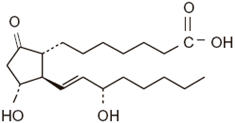
-
12 CLINICAL PHARMACOLOGY
12.1 Mechanism of Action
Alprostadil (PGE1) is a prostaglandin with a wide variety of pharmacological actions including vasodilation and inhibition of platelet aggregation. Alprostadil induces erection by relaxation of trabecular smooth muscle and by dilation of cavernosal arteries by binding to its receptors and increasing intracellular cyclic adenosine monophosphate (cAMP) levels via modulation of adenylate cyclase. This leads to expansion of lacunar spaces and entrapment of blood by compressing the venules against the tunica albuginea, a process referred to as the corporal veno-occlusive mechanism. Alprostadil also attenuates presynaptic noradrenaline release in the corpus cavernosum.
Studies in vitro have shown that alprostadil relaxed isolated preparations of human corpus cavernosum and spongiosum, as well as cavernous arterial segments contracted by either noradrenaline or PGF2α. In pigtail monkeys (Macaca nemestrina), alprostadil increased cavernous arterial blood flow in a dose-dependent manner in vivo.
12.3 Pharmacokinetics
Absorption: For the treatment of erectile dysfunction, alprostadil is administered by injection into the corpora cavernosa. The absolute bioavailability of alprostadil has not been determined.
Distribution: Following intracavernosal injection of 20 mcg alprostadil, mean peripheral plasma concentrations of alprostadil at 30 and 60 minutes after injection (89 picograms/mL and 102 picograms/mL, respectively) were not significantly greater than baseline levels of endogenous alprostadil (96 picograms/mL). Plasma levels of alprostadil were measured using a radioimmunoassay method. Alprostadil is bound in plasma primarily to albumin (81% bound) and to a lesser extent α-globulin IV-4 fraction (55% bound). No significant binding to erythrocytes or white blood cells was observed.
Metabolism: Alprostadil is converted to compounds which are further metabolized prior to excretion. Following intravenous administration, approximately 80% of circulating alprostadil is metabolized in one pass through the lungs, primarily by beta- and omega-oxidation. Following intracavernosal injection of 20 mcg alprostadil, peripheral levels of the major circulating metabolite, 13, 14-dihydro-15-oxo-PGE1, increased to reach a peak 30 minutes after injection and returned to pre-dose levels by 60 minutes after injection.
Excretion: The metabolites of alprostadil are excreted primarily by the kidney, with almost 90% of an administered intravenous dose excreted in urine within 24 hours post-dose. The remainder of the dose is excreted in the feces. There is no evidence of tissue retention of alprostadil or its metabolites following intravenous administration.
- 13 NONCLINICAL TOXICOLOGY
-
14 CLINICAL STUDIES
The efficacy of CAVERJECT was investigated in men with a diagnosis of erectile dysfunction due to psychogenic, vasculogenic, neurogenic, and/or mixed etiology in two double-blind placebo controlled studies (Study 1 and Study 2) and in one 6-month open-label study (Study 3). In clinical studies (Study 1 and Study 3), over 80% of patients experienced an erection sufficient for sexual intercourse after intracavernosal injection of CAVERJECT.
Study 1: A total of 153 men with ED with a mean age of 53 years (range 23–69 years) were enrolled. The study had three phases: a 2.5 week, randomized, double-blind, placebo-controlled crossover phase in which each man received in-office injections of placebo or 2.5 mcg, 5 mcg, 7.5 mcg, or 10 mcg of CAVERJECT; a 2 week, open-label, in-office dose-titration phase to identify the optimum home-use dose (the latter dose was defined as a dose inducing an erection sufficient for intercourse and lasting ≤ 60 minutes); and a 4-week open-label, at-home phase. In the double-blind placebo-controlled, crossover phase, each dose of CAVERJECT was significantly more effective than placebo by clinical evaluation ("full penile rigidity") and by RigiScan criteria (≥ 70% rigidity for at least 10 minutes); there was no response to placebo. The percentage of responders increased with increasing doses of CAVERJECT. The overall response rates in the crossover and dose-titration phases were 76% (117/153) by clinical evaluation and 51% (78/152) by RigiScan criteria. Seventy-three percent of the injections in 102 men who used CAVERJECT in the at-home phase resulted in satisfactory intercourse. Seventy-five percent of the men who used CAVERJECT in the at-home phase remained on the dose identified as optimum for them during the dose-titration phase; 17% and 8% of the men decreased or increased their dose, respectively. The mean duration of erection per injection was 70.8 minutes.
Study 2: A total of 296 men with ED with a mean age of 54 years (range 21–74 years) were enrolled in this double-blind, placebo controlled, parallel-arm design study. The men were randomly assigned to one of five groups and received either a single dose of placebo, 2.5 mcg, 5 mcg, 10 mcg, or 20 mcg of CAVERJECT. No patient responded to placebo. The differences in the response rates in both the clinical and the RigiScan evaluations between each of the doses of CAVERJECT and placebo were statistically significant. There was also a statistically significant dose-response relationship with higher clinical response rates and higher RigiScan response rates with increasing doses of CAVERJECT (with exception of the 10-mcg dose). The mean duration of erection after injection ranged from 12 minutes after the 2.5-mcg dose to 44 minutes after the 20-mcg dose and the relationship was linear (p = .025, linear regression analysis).
Study 3: The efficacy of CAVERJECT was further evaluated in a 6-month, open-label, at-home study in 683 men with ED with a mean age of 58 years (range 20–79 years). The optimum dose of CAVERJECT was established by titration in 89% of men (606/683). A total of 471/683 men (69%) completed the 6-month study. Eighty-seven percent of the 13,762 injections of CAVERJECT administered resulted in satisfactory sexual activity. The mean duration of erection was 67.5 minutes.
The formulation of alprostadil contained in CAVERJECT IMPULSE was compared to CAVERJECT in 87 men with ED in a single-blind, crossover study. The doses used by the patients in the study ranged from 2.5 mcg to 20 mcg and were the same for both formulations. The efficacy of the two formulations was shown to be comparable, as assessed by the 30-point erectile function (EF) domain score from the International Index of Erectile Function (IIEF) and by a physician-assessment score for erectile response. The mean EF domain scores for CAVERJECT and the formulation contained in CAVERJECT were 26.6 (SD=5.3) and 27.6 (SD=3.8), respectively. The mean physician's assessment scores for CAVERJECT and the formulation contained in CAVERJECT IMPULSE were 2.6 (SD=0.6) and 2.7 (SD=0.5), respectively, based on a scale of 0 (no tumescence) to 3 (full rigidity).
-
16 HOW SUPPLIED/STORAGE AND HANDLING
CAVERJECT is a lyophilized powder supplied in vials containing 23.2 or 46.4 mcg of alprostadil for intracavernosal administration. When reconstituted as directed with 1 milliliter of bacteriostatic water for injection preserved with benzyl alcohol 0.945% w/v, the delivered amount of alprostadil is 20 mcg or 40 mcg.
Store CAVERJECT 20 mcg vials between 20°C to 25°C (68°F to 77°F). The reconstituted solution should be used within 24 hours when stored at or below 25°C (77°F) and not refrigerated or frozen.
Store CAVERJECT 40 mcg vials between 2°C to 8°C (36° to 46°F) until dispensed. Once dispensed, vials should be stored at or below 25°C (77°F) for up to 3 months or until the expiration date, whichever occurs first. The reconstituted solution should be used within 24 hours when stored at or below 25°C (77°F) and not refrigerated or frozen.
When reconstituted and used as directed, the deliverable amount of alprostadil is 20 micrograms or 40 micrograms, respectively. Only bacteriostatic water for injection preserved with benzyl alcohol 0.945% w/v, should be used when reconstituting CAVERJECT.
CAVERJECT is available in the following packages:
Package of six 20 mcg vials NDC: 0009-3701-05 Package of six 40 mcg vials NDC: 0009-7686-04 The following supplies are needed for injection and are not supplied with CAVERJECT:
- 1 mL of the diluent (bacteriostatic water for injection preserved with benzyl alcohol 0.945% w/v)
- 1 mL to 3 mL syringe, dependent on the titrated dose
- 21 to 27 gauge needle for reconstitution
- 29 or 30 gauge one-half inch needle for injection
- alcohol swabs
-
17 PATIENT COUNSELING INFORMATION
Advise the patient to read the FDA-approved patient labeling (Patient Information and Instructions for Use).
Dosing and Self-Administration
To ensure safe and effective use of CAVERJECT, instruct and train the patient in the self-injection technique before he begins intracavernosal treatment with CAVERJECT, at home. Inform the patient the initial dose administration and dose titration will take place in the physician's office [see Dosage and Administration (2.1)].
Once the home dose of CAVERJECT has been established instruct the patient not to change the dose without consulting their physician.
The patient may expect an erection to occur within 5 minutes to 20 minutes and it should last no longer than 1 hour. CAVERJECT should be used no more than 3 times per week, with at least 24 hours between each use [see Dosage and Administration (2.2)].
Inform the patient that they must visit the physician's office for regular check-ups for assessment of the therapeutic benefit and safety of treatment with CAVERJECT.
When self-administering the patient should be instructed to [see Dosage and Administration (2.2, 2.3)]:
- Discard any reconstituted solution with precipitates or discoloration
- Administer the injection along the dorso-lateral aspect of the proximal third of the penis
- Wipe the intended injection site with an alcohol swab prior to injection
- Avoid visible veins during injection
- Alternate the side of the penis that is injected and the site of injection
- Compress the site of injection with an alcohol swab or sterile gauze for 5 minutes
- Use each CAVERJECT vial only once and discard after use. Use a new vial of CAVERJECT for each dose.
- Not use a bent needle for reconstitution or injection. Do not attempt to straighten a bent needle. Remove the needle from the syringe, discard it, and attach a new, unused sterile needle to the syringe.
- Not re-use or share needles and to properly discard after use
Needle Breakage
Advise patients that needle breakage has occurred during self-injection of CAVERJECT. Advise patients to insert the needle perpendicular to the long access of the penis to avoid bending or breakage of the needle [see Dosage and Administration (2.4), Warnings and Precautions (5.7) and Adverse Reactions (6.2)].
Penile Pain
Advise patients that the most frequently occurring side-effect is penile pain after injection, and is usually mild to moderate in severity [see Adverse Reactions (6.1)].
Priapism
A potentially serious adverse reaction with intracavernosal therapy of CAVERJECT is priapism. Instruct the patient to seek immediate medical assistance if an erection persists for longer than 4 hours [see Warnings and Precautions (5.1)].
Penile Fibrosis
Penile fibrosis has been reported in clinical studies with CAVERJECT. Advise the patient to report any penile pain that was not present before or that increased in intensity, as well as the occurrence of nodules or hard tissue in the penis or curvature of the erect penis to his physician as soon as possible. [see Warnings and Precautions (5.2)].
Injection Site Reactions
Inform the patient that injection of CAVERJECT can induce a small amount of bleeding at the site of injection and that hematoma and ecchymosis may occur. Advise the patient to report any persistent redness, tenderness or swelling [see Warnings and Precautions (5.4)].
Sexually Transmitted Disease
Use of intracavernosal CAVERJECT offers no protection from the transmission of sexually transmitted diseases. Advise the patient about the protective measures that are necessary to guard against the spread of sexually transmitted diseases, including the human immunodeficiency virus (HIV) [see Warnings and Precautions (5.9)].
- SPL UNCLASSIFIED SECTION
-
Patient Information
CAVERJECT [KAV-er-jeckt]®
(alprostadil)
for injection, for intracavernosal useRead this Patient Information before you start using CAVERJECT and each time you get a refill. There may be new information. This information does not take the place of talking to your healthcare provider about your medical condition or your treatment.
What is CAVERJECT?
CAVERJECT is a prescription medicine used:
- to treat erectile dysfunction (ED).
- with other medical tests to diagnose ED.
CAVERJECT is not meant for use in women or children.
Do not use CAVERJECT if you:
- are allergic to alprostadil or any of the ingredients in CAVERJECT. See the end of this leaflet for a complete list of ingredients in CAVERJECT.
- have certain medical problems that might cause you to have an erection that lasts for more than 4 hours, such as sickle cell anemia, sickle cell trait, multiple myeloma, leukemia.
- have a deformed penis shape
- have a penile implant
Before you use CAVERJECT, tell your healthcare provider about all your other medical conditions, especially if you:
- have had an erection that lasted more than 4 hours
- have sickle cell trait or sickle cell anemia
- have or have had a blood cell cancer called multiple myeloma or leukemia
- have a deformed penis shape
- have a penile implant
- have low blood pressure (hypotension)
- have bleeding problems
- have or have had heart problems such as a heart attack, irregular heartbeat, angina, chest pain, narrowing of the aortic valve or heart failure
Tell your healthcare provider about all the medicines you take, including prescription and over-the-counter medicines, vitamins, and herbal supplements.
CAVERJECT may affect the way other medicines work, and other medicines may affect the way CAVERJECT works causing side effects.
Especially tell your healthcare provider if you take any other medicines that are treatments for ED, other medicines injected into your penis (intracavernosally), or certain medicines called anticoagulant medicines (such as heparin or warfarin).
Ask your healthcare provider or pharmacist for a list of these medicines if you are not sure.
Know the medicines you take. Keep a list of them to show to your healthcare provider and pharmacist when you get a new medicine.
How should I use CAVERJECT?
- See the detailed Instructions for Use that comes with your CAVERJECT for information about how to prepare and inject CAVERJECT the right way.
- You should receive your first dose of CAVERJECT in your healthcare provider's office.
- Use CAVERJECT exactly as your healthcare provider tells you to.
- Your healthcare provider will tell you how much CAVERJECT to use and when to use it.
- Your healthcare provider may change your dose if needed. Do not change your dose of CAVERJECT without first talking to your healthcare provider.
- Your healthcare provider should show you how to prepare and inject CAVERJECT the right way before you inject it for the first time.
- CAVERJECT should not be used more than 3 times per week.
- CAVERJECT should not be used more than 1 time every 24 hours.
- Change the exact place and side of the penis that you inject CAVERJECT each time you use it.
- CAVERJECT is for 1 time use only and should be thrown away properly after each use.
You should see your healthcare provider every 3 months for check-ups to be sure that CAVERJECT is working the right way and to change your CAVERJECT dose if needed.
What are the possible side effects of CAVERJECT?
CAVERJECT may cause serious side effects, including:
- an erection that will not go away (priapism). If you have an erection that lasts more than 4 hours, get medical help right away. If it is not treated right away, this condition can permanently damage your penis.
- deformed penis shape (penile fibrosis). Your healthcare provider should check your penis regularly for signs of penile fibrosis. You should not continue to use CAVERJECT if you get penile fibrosis.
- low blood pressure (hypotension).
- injection site bleeding. People who take certain medicines called anticoagulants (such as heparin or warfarin) may have a risk for increased bleeding at the injection site.
- increased risk of heart problems. Sexual activity can put an extra strain on your heart, especially if your heart is weak from a heart attack or heart disease. Ask your healthcare provider if your heart is healthy enough to handle the extra strain of having sex. Stop sexual activity and get medical help right away if you get symptoms of a heart problem such as chest pain, dizziness or nausea.
- needle breakage. There is a possibility of needle breakage with use of CAVERJECT. To best avoid breaking the needle, you should pay careful attention to your healthcare provider's instructions and try to handle the syringe and needle properly. If the needle breaks during injection and you are able to see and grasp the broken end, you should remove it and contact your healthcare provider. If you cannot see or cannot grasp the broken end, you should promptly contact your healthcare provider.
- benzyl alcohol toxicity. Benzyl alcohol is a preservative that is present in CAVERJECT when it is mixed. Benzyl alcohol has caused serious side effects, including death, in children, especially premature and low-birth weight infants, who have received the preservative benzyl alcohol. CAVERJECT is not meant for use in children.
CAVERJECT does not protect you or your partner from getting sexually transmitted infections, including HIV-the virus that causes AIDS.
The most common side effect of CAVERJECT is penile pain
These are not all the possible side effects of CAVERJECT.
Call your doctor for medical advice about side effects. You may report side effects to FDA at 1-800-FDA-1088.
General information about the safe and effective use of CAVERJECT
Medicines are sometimes prescribed for purposes other than those listed in a Patient Information Leaflet. Do not use CAVERJECT for a condition for which it was not prescribed. Do not give CAVERJECT to other people even if they have the same symptoms that you have. It may harm them.
You can ask your pharmacist or healthcare provider for information about CAVERJECT that is written for health professionals.
What are the Ingredients in CAVERJECT?
Active ingredient: alprostadil
Inactive ingredients: alpha cyclodextrin, lactose, sodium citrate, benzyl alcohol (contained in the final solution) and hydrochloric acid and/or sodium hydroxide for pH adjustment.

LAB-1045-1.0
Revised: December 2017
-
INSTRUCTIONS FOR USE
CAVERJECT [KAV-er-jeckt]®
(alprostadil)
for injection, for intracavernosal useYour healthcare provider should show you how to prepare and inject CAVERJECT the right way before you inject it for the first time. Do not try to inject yourself until you have been shown the right way to give your injections by your healthcare provider.
Information about how to safely inject CAVERJECT:
- Read and follow these instructions so that you inject CAVERJECT the right way. Call your healthcare provider if you have any questions about the right way to inject CAVERJECT.
- Separate needles should be used for reconstitution and administration. Do not use damaged or bent needles to inject CAVERJECT.
- If you accidentally bend a needle, do not attempt to straighten it.
- Using bent or re-straightened needles may cause part of the needle to break off and remain in the penis. Some people have reported needle breakage in their penis during the injection and, in some cases, had to go to hospital for surgery to remove the needle.
- If you accidentally bend the needle while preparing your CAVERJECT injection, remove it from the syringe, throw it away, and attach a new, needle to the syringe as described under "Prepare the Dose" below. (See "Dispose of your used CAVERJECT syringe and needle" at the end of these Instructions).
- Do not share your needles or syringes with other people, even if the needle has been changed. You may give other people a serious infection, or get a serious infection from them.
- Use the needles, syringe, alcohol swabs, and vials only 1 time then safely throw away the supplies and any unused solution in a puncture resistant container (See "Dispose of your used CAVERJECT syringe and needle" at the end of these instructions). Ask your healthcare provider or pharmacist where you can get a puncture resistant or sharps container.
Supplies you will need to give your CAVERJECT injection (Figure A) - 1 CAVERJECT sterile powder vial
- 1 - diluent vial (bacteriostatic water for injection)
- 1 - sterile 1 milliliter (mL) to 3 mL syringe
- 1 - 21 to 27 gauge sterile needle to mix the medicine
- 1 - 29 or 30 gauge one-half inch needle for injection
- 2 - alcohol swabs
- 1 - puncture-resistant or sharps container (not shown) for throwing away the used CAVERJECT syringe and needle. See "Dispose of your used CAVERJECT syringe and needle" at the end of these instructions.
Figure A: Supplies you will need for your Injection.
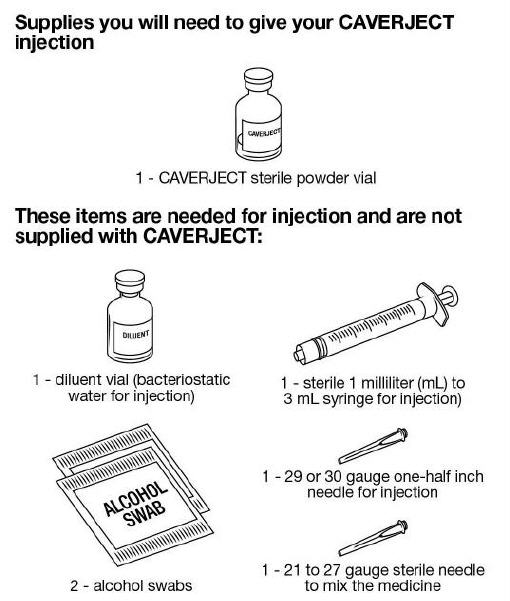
Follow the instructions below to prepare and give your injection. Figure B explains the parts of the needle and syringe that are referred to in the instructions. Figure B: Parts of the needle and syringe

CAVERJECT comes in 20 mcg or 40 mcg strengths. Make sure you have the right strength vial of CAVERJECT that your healthcare provider prescribed for you.
Prepare the Syringe
Step 1. Wash your hands thoroughly, and dry them with a clean towel. Step 2. Assemble the needle and syringe as follows: - Remove the syringe from its sterile wrapping. (Figure C)
Figure C: Remove the syringe
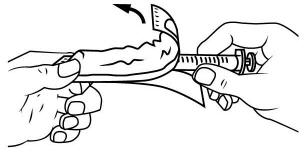
- Use a 21 to 27 gauge needle. Carefully pull the wrapper tabs back enough to expose the sterile open end of the needle assembly. Do not completely remove the wrapper.
- Do not touch the open end of the needle (Figure D).
Figure D: Open the needle wrapper

Step 3. Keeping hold of the needle assembly, remove the plastic syringe cap from the syringe tip (Figure E). Do not touch the syringe tip. Figure E: Remove the syringe cap
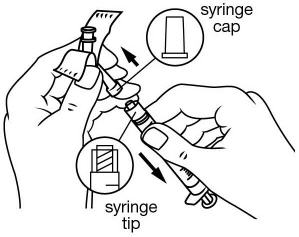
Step 4. Hold the needle assembly (still in the paper wrapper). Firmly attach the needle to the syringe tip. Turn it clockwise, like tightening a screw to lock it in place (Figure F). - With the needle cover in place, set the syringe and needle down on a clean, level surface, like a table.
Figure F: Attach the needle to the syringe
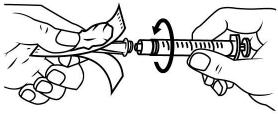
Mixing the powder and liquid to prepare the dose Step 5. Remove the plastic cap from the vial of CAVERJECT and remove any cover from the diluent (Figure G). Figure G: Remove the vial cap
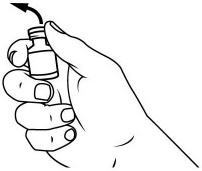
Step 6. Wipe the rubber stoppers on the vials of CAVERJECT and diluent with 1 alcohol swab. Throw away the alcohol swab. Step 7. Carefully hold the syringe by the barrel and remove the needle cover (Figure H). - Do not discard the needle cover, you will need to use it again (see step 13).
- Do not touch the needle.
Figure H: Remove the needle cover

Step 8. Hold the syringe with the needle attached and push the needle through the center of the diluent vial's rubber stopper (Figure I). Be careful not to bend the needle. Figure I: Push the needle into the diluent vial
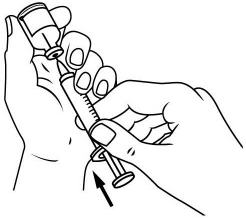
- Keeping the needle in the vial, firmly hold the vial and syringe upside down in one hand (see Figure J).
- Keep the needle tip below the level of the liquid and pull back on the syringe plunger until all the diluent is removed from vial.
Figure J: Remove the liquid from the vial
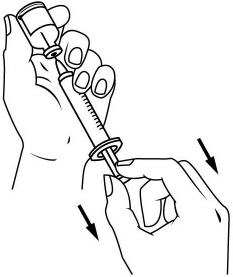
Step 9. Push the syringe plunger to the 1mL mark on the syringe. This will remove air and extra liquid back into vial.
Grasp the side of the syringe barrel (not the plunger) and pull the needle from the diluent vial in a straight line to avoid bending the needle (Figure K).Figure K: Adjust the amount of liquid in the syringe
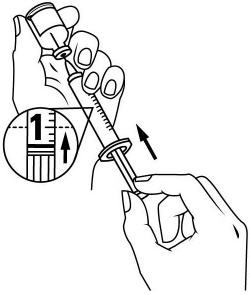
Step 10. Holding the syringe with the needle attached in a straight line with the vial of CAVERJECT, push the needle through the center of the rubber stopper of the vial of CAVERJECT. Be careful not to bend the needle. - Push the syringe plunger all the way down to move all the liquid into the vial. Go immediately to step 11.
Figure L: Push the needle into the CAVERJECT vial

Step 11. Without removing the needle or touching the needle or stopper, gently swirl (do not shake) the vial until all the powder is dissolved in the liquid. Then turn the vial and needle/syringe upside down and gently swirl the vial to dissolve any powder in the neck of the vial. Do not use the solution if it is cloudy, colored, or contains particles. Step 12. Keeping the needle in the vial, firmly hold the vial and syringe upside down in one hand. - Keeping the needle tip below the level of the liquid, slowly pull back on the syringe plunger until all the liquid is removed from the vial (see Figure M).
Figure M: Remove the liquid from the vial
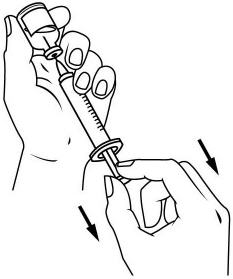
Step 13. If there are air bubbles, gently tap the syringe barrel until the bubbles float to the top of the liquid (see Figure N). - Holding the syringe upright, push the syringe plunger to the correct volume mark for the dose prescribed by your healthcare provider. This will remove any air and extra liquid into the vial.
- Grasp the syringe barrel (not the plunger) and pull the needle/syringe straight out of the vial of CAVERJECT in a straight line to avoid and be sure not to bend the needle.
- Carefully replace the needle cover over the needle that you used to mix the liquid.
Figure N: Tap the syringe barrel to remove air bubbles
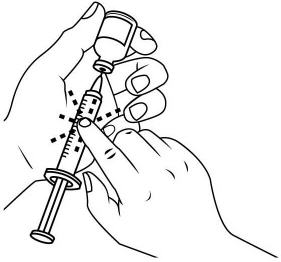
Step 14. Carefully replace the needle used to mix the liquid with a new 29 to 30 gauge one half inch needle for your injection. - Remove the old needle from the syringe and immediately throw it away in an FDA-cleared sharps disposal container.
- Unwrap the new needle as in step 2.
- Attach the new needle as in step 3.
How to give the injection - Make yourself comfortable. You should be sitting upright or slightly reclined when injecting CAVERJECT.
- Make sure that the needle is not bent. If it is, do not use it. Do not attempt to straighten the needle out. Properly throw away any bent needles.
STEP 15. The injection will go into the part of the penis shown as the shaded area in Figure O. Do not inject CAVERJECT into the white areas because there may be blood vessels in the white areas. (See Figure P). - The correct injection angle and depth of injection is shown in Figure P.
- With each injection of CAVERJECT change the side of the shaft of the penis, and choose a different location for each injection, as shown in the shaded area in Figure O.
Figure O: Top view of the penis showing injection sites (shaded areas).

Figure P: Cross-section of the penis
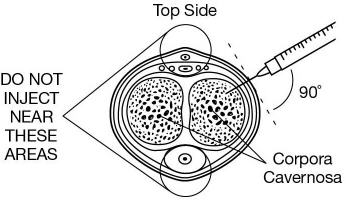
Step 16. Wipe the area for injection with an alcohol swab and let it dry. Step 17. Do not throw away the swab; you will need to use it again after you give your injection. (See Step 23). Step 18. If your penis is not circumcised, pull the foreskin back. Take hold of the tip of your penis with your thumb and forefinger; stretch it length-wise along your thigh. Step 19. Gently squeeze your penis between your thumb and finger so that the injection site bulges out. Step 20. Remove the cover from the needle. Position your penis firmly against your thigh to keep it from moving during the injection. Step 21. Keeping a firm grip on your penis, take the syringe in your other hand, and push the needle straight into the selected injection site (See Figure Q). - Refer to Figure P for the correct angle and depth of injection.
- Do not inject CAVERJECT into veins or other blood vessels (the white areas in Figure O).
Figure Q: Insert the needle into the injection site
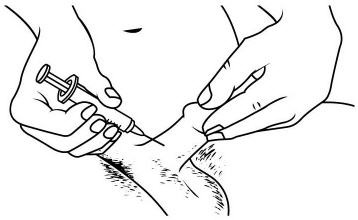
Step 22. Holding the syringe barrel between two fingers, move your thumb or finger to the top of the plunger and, with a steady motion, push down on the plunger so that the entire contents of the syringe is slowly injected (Figure R). Figure R: Inject the contents of the syringe.
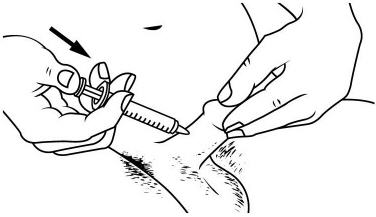
Step 23. After completing the injection, carefully pull the needle out of your penis. Press gently on the injection site with the alcohol swab for about 5 minutes or until bleeding stops. After your injection:
Dispose of your used CAVERJECT syringe and needles.
- Put your used CAVERJECT syringe and needles in a FDA-cleared sharps disposal container right away after use. Do not throw away loose needles and syringes in your household trash.
- If you do not have a FDA-cleared sharps disposal container, you may use a household container that is:
- made of a heavy-duty plastic
- can be closed with a tight-fitting, puncture-resistant lid, without sharps being able to come out
- upright and stable during use
- leak-resistant
- properly labeled to warn of hazardous waste inside the container
- When your sharps disposal container is almost full, you will need to follow your community guidelines for the right way to dispose of your sharps disposal container. There may be state or local laws about how you should throw away used needles and syringes. Do not reuse or share your needles or syringes with other people. For more information about the safe sharps disposal, and for specific information about sharps disposal in the state that you live in, go to the FDA's website at: http://www.fda.gov/safesharpsdisposal.
- Do not dispose of your used sharps disposal container in your household trash unless your community guidelines permit this. Do not recycle your used sharps disposal container.
How should I store CAVERJECT?
CAVERJECT 20 mcg vial storage information
- Store CAVERJECT 20 mcg vials between 20°C to 25°C (68°F to 77°F).
- The reconstituted solution should be used within 24 hours when stored at or below 25°C (77°F) and not refrigerated or frozen.
CAVERJECT 40 mcg vial storage information
- Store CAVERJECT 40 mcg vials between 2°C to 8°C (36°F to 46°F) until dispensed. Once dispensed, vials should be stored at or below 25°C (77°F) for up to 3 months or until the expiration date, whichever occurs first.
- The reconstituted solution should be used within 24 hours when stored at or below 25°C (77°F) and not refrigerated or frozen.
Keep CAVERJECT and all medicines out of the reach of children.
This Patient Information and Instructions for Use has been approved by the U.S Food and Drug Administration.

LAB-0009-6.0
Revised December 2017
-
PRINCIPAL DISPLAY PANEL - 20 mcg Vial Label
NDC: 0009-3701-08
Pfizer
Caverject®
alprostadil for injection20 mcg
For Intracavernosal Use Only
Single Dose Vial
Rx only
-
PRINCIPAL DISPLAY PANEL - 20 mcg Vial Package
NDC: 0009-3701-05
Contains 6 of NDC: 0009-3701-08Pfizer
Caverject®alprostadil for
injectionFor Intracavernosal Use Only
6 Single-Dose Vials
20 mcg
Diluent to be used with this product should
contain benzyl alcohol as a preservative.This Package Does NOT Contain Diluent
Rx only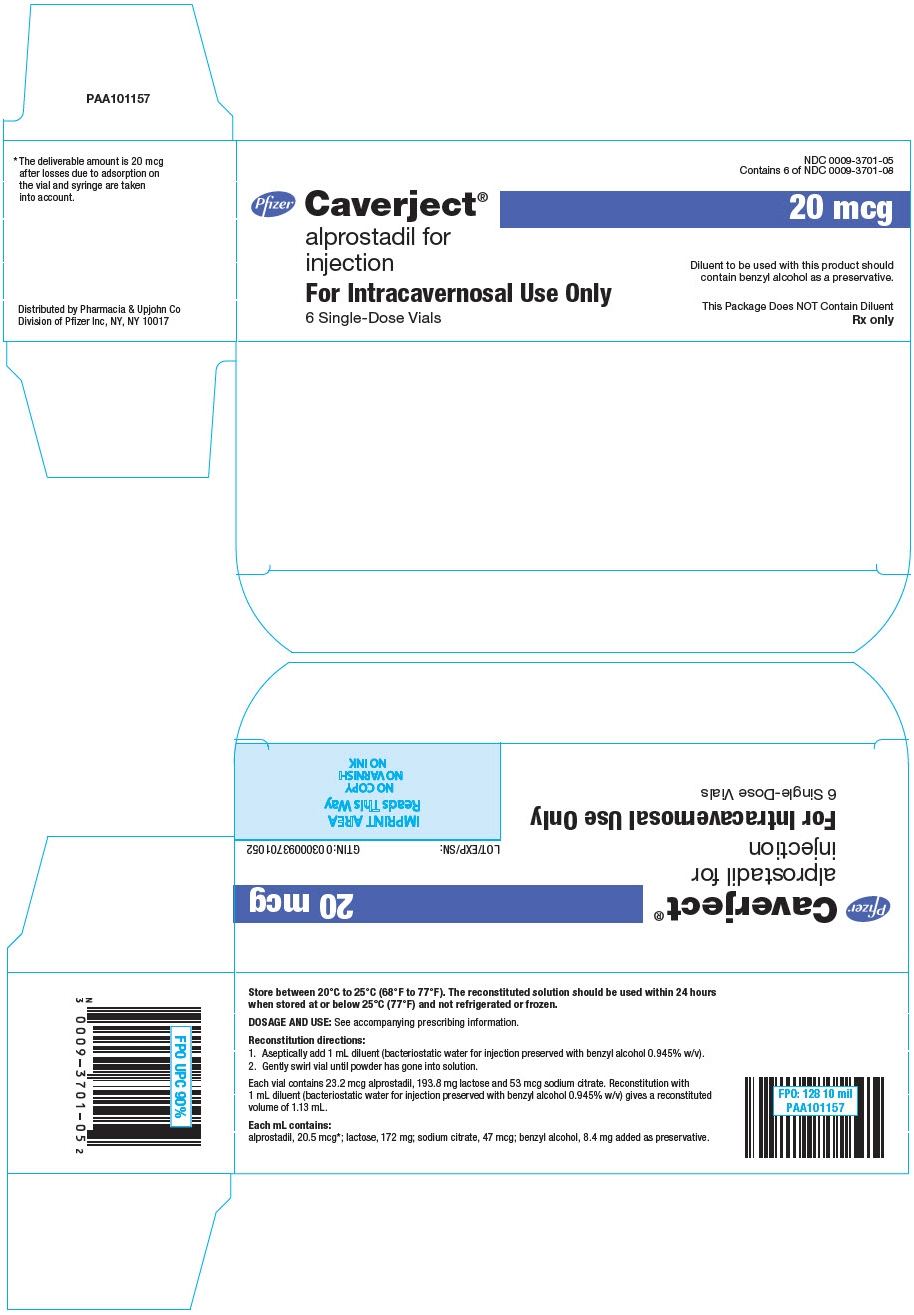
-
PRINCIPAL DISPLAY PANEL - 40 mcg Vial Label
NDC: 0009-7686-01
Pfizer
Caverject®
alprostadil for injection40 mcg
For Intracavernosal Use Only
Single Dose Vial
Rx only
-
PRINCIPAL DISPLAY PANEL - 40 mcg Vial Package
NDC: 0009-7686-04
Contains 6 of NDC: 0009-7686-01Pfizer
Caverject®alprostadil for
injectionFor Intracavernosal Use Only
6 Single-Dose Vials
40 mcg
Diluent to be used with this product should
contain benzyl alcohol as a preservative.This Package Does NOT Contain Diluent
Rx only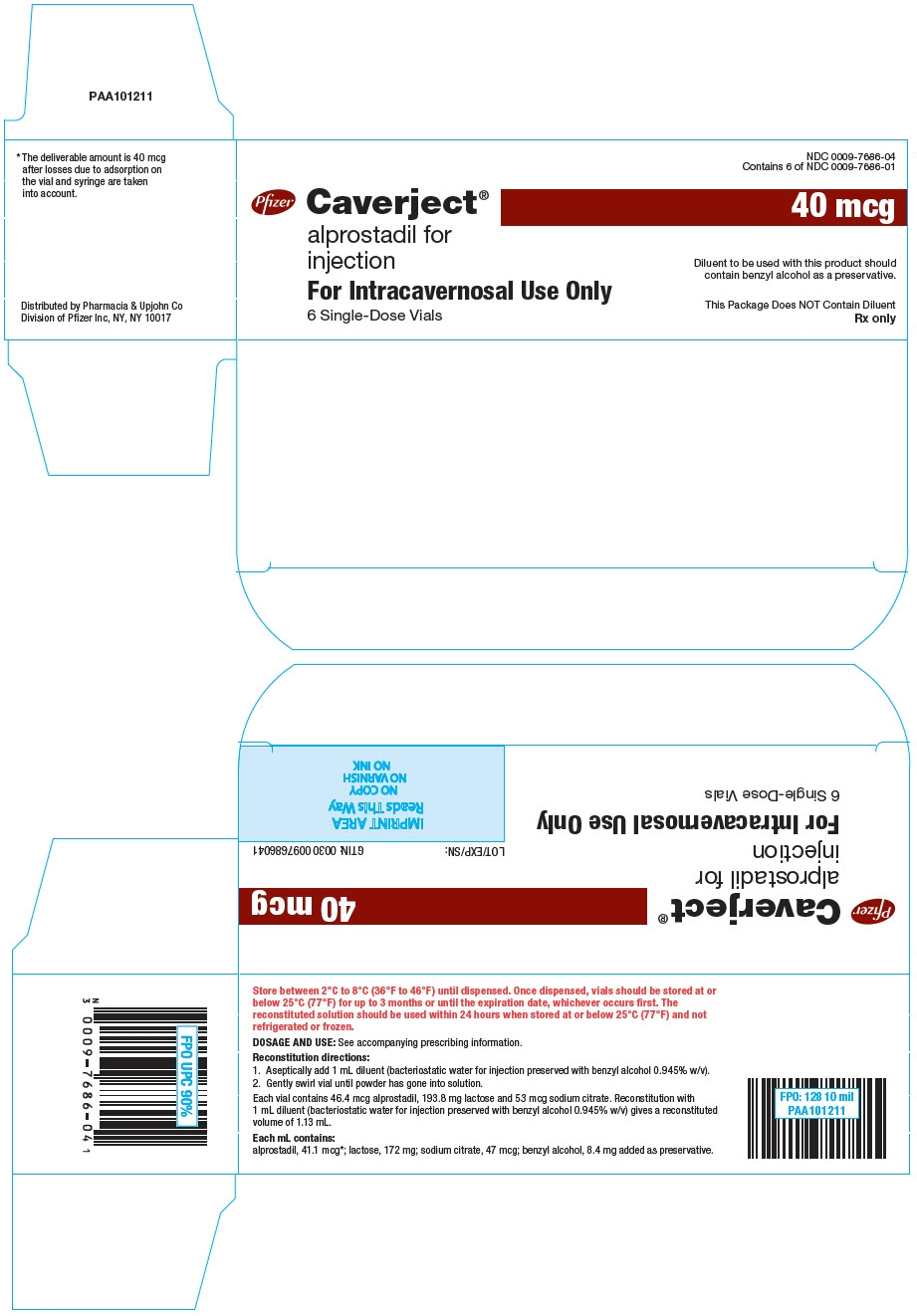
-
INGREDIENTS AND APPEARANCE
CAVERJECT
alprostadil injection, powder, lyophilized, for solutionProduct Information Product Type HUMAN PRESCRIPTION DRUG Item Code (Source) NDC: 0009-3701 Route of Administration INTRACAVERNOUS Active Ingredient/Active Moiety Ingredient Name Basis of Strength Strength ALPROSTADIL (UNII: F5TD010360) (ALPROSTADIL - UNII:F5TD010360) ALPROSTADIL 20.5 ug in 1 mL Inactive Ingredients Ingredient Name Strength LACTOSE, UNSPECIFIED FORM (UNII: J2B2A4N98G) 172 mg in 1 mL SODIUM CITRATE, UNSPECIFIED FORM (UNII: 1Q73Q2JULR) 47 ug in 1 mL BENZYL ALCOHOL (UNII: LKG8494WBH) 8.4 mg in 1 mL HYDROCHLORIC ACID (UNII: QTT17582CB) SODIUM HYDROXIDE (UNII: 55X04QC32I) WATER (UNII: 059QF0KO0R) Packaging # Item Code Package Description Marketing Start Date Marketing End Date 1 NDC: 0009-3701-05 6 in 1 PACKAGE 07/06/1995 1 NDC: 0009-3701-08 1 mL in 1 VIAL, SINGLE-DOSE; Type 0: Not a Combination Product Marketing Information Marketing Category Application Number or Monograph Citation Marketing Start Date Marketing End Date NDA NDA020379 07/06/1995 CAVERJECT
alprostadil injection, powder, lyophilized, for solutionProduct Information Product Type HUMAN PRESCRIPTION DRUG Item Code (Source) NDC: 0009-7686 Route of Administration INTRACAVERNOUS Active Ingredient/Active Moiety Ingredient Name Basis of Strength Strength ALPROSTADIL (UNII: F5TD010360) (ALPROSTADIL - UNII:F5TD010360) ALPROSTADIL 41.1 ug in 1 mL Inactive Ingredients Ingredient Name Strength LACTOSE, UNSPECIFIED FORM (UNII: J2B2A4N98G) 172 mg in 1 mL SODIUM CITRATE, UNSPECIFIED FORM (UNII: 1Q73Q2JULR) 47 ug in 1 mL BENZYL ALCOHOL (UNII: LKG8494WBH) 8.4 mg in 1 mL HYDROCHLORIC ACID (UNII: QTT17582CB) SODIUM HYDROXIDE (UNII: 55X04QC32I) WATER (UNII: 059QF0KO0R) Packaging # Item Code Package Description Marketing Start Date Marketing End Date 1 NDC: 0009-7686-04 6 in 1 PACKAGE 07/06/1995 1 NDC: 0009-7686-01 1 mL in 1 VIAL, SINGLE-DOSE; Type 0: Not a Combination Product Marketing Information Marketing Category Application Number or Monograph Citation Marketing Start Date Marketing End Date NDA NDA020379 07/06/1995 Labeler - Pharmacia and Upjohn Company LLC (618054084) Registrant - Pfizer Inc (113480771) Establishment Name Address ID/FEI Business Operations Pharmacia and Upjohn Company LLC 618054084 ANALYSIS(0009-3701, 0009-7686) , API MANUFACTURE(0009-3701, 0009-7686) , LABEL(0009-3701, 0009-7686) , MANUFACTURE(0009-3701, 0009-7686) , PACK(0009-3701, 0009-7686)
Trademark Results [Caverject]
Mark Image Registration | Serial | Company Trademark Application Date |
|---|---|
 CAVERJECT 74329204 1835984 Live/Registered |
PHARMACIA & UPJOHN COMPANY LLC 1992-11-06 |
© 2026 FDA.report
This site is not affiliated with or endorsed by the FDA.
